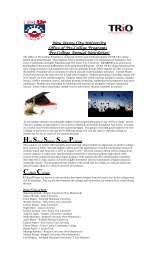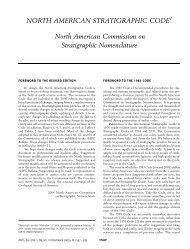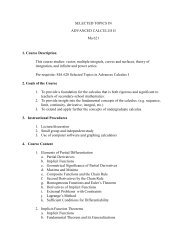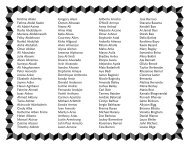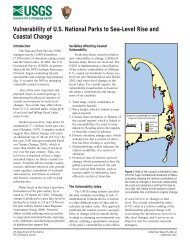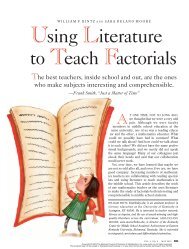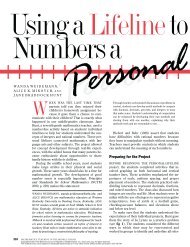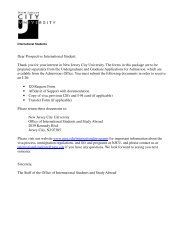Patterns with checkers.
Patterns with checkers.
Patterns with checkers.
- No tags were found...
You also want an ePaper? Increase the reach of your titles
YUMPU automatically turns print PDFs into web optimized ePapers that Google loves.
While playing a popular game <strong>with</strong> <strong>checkers</strong>, studentsexperience patterns that can be expressed using symbols.<strong>Patterns</strong><strong>with</strong>418 Mathematics Teaching in the Middle School ● Vol. 14, No. 7, March 2009Copyright © 2009 The National Council of Teachers of Mathematics, Inc. www.nctm.org. All rights reserved.This material may not be copied or distributed electronically or in any other format <strong>with</strong>out written permission from NCTM.
CheckersKathy J. LewisaA familiar middle school game can yield some interesting mathematical patterns.The game is known by several names, such as frogs and toads or the frog puzzle(see hellam.net/maths2000/frogs.html). In the pre-Internet era, it was knownsimply as the pawn puzzle (Ball 1962). See figure 1 on the next page to read howit was described in the 1930s in Ball’s delightful book.The purpose of this article is to identify some interesting patterns that both studentsand teachers can examine by showing how these patterns emerge.Bonnie Jacobs/iStockphoto.comKathy Lewis, kathylewis@fullerton.edu, teaches calculuscourses at CaliforniaState University, Fullerton.She works extensively<strong>with</strong> preservice and in-service teachersat the university and <strong>with</strong> local schooldistricts. Her professional art backgroundis often incorporated into her lessons asshe and her students delve into the mathematicsbehind the art.LEVEL 1: A THREE-SQUARE BOARDTo start, examine the simplest version of the game using three squares, <strong>with</strong> onepiece on each side. For tracking purposes, the white piece on the left will be denotedby W 1, and the black piece on the right will be B 1. Using subscripted numbersto refer to the pieces will allow us to keep track of which piece makes whichmove. In the diagrams, <strong>checkers</strong> will appear as white circles or solid black circles.In the game, there are only two possible moves: a slide (S) if an adjacent space isopen and a jump ( J) if the adjacent space is occupied by a piece of a different colorand if the space beyond it is open. In this article, S(W 1) and J(W 1) will refer to awhite piece either sliding or jumping, as in figure 2 on the next page.This game took three moves. First, W 1slid to the middle [S(W 1)], then B 1jumped W 1[ J(B 1)], and finally W 1slid to the end position [S(W 1)]. It can also benotated simply as S-J-S, meaning that there was a slide, a jump, and another slide.Vol. 14, No. 7, March 2009 ● Mathematics Teaching in the Middle School 419
Fig. 1 The Frog PuzzleOn a row of seven squares on a chess board 3 white pawns (or counters),denoted in the diagram by “w”s, are placed on the 3 squares at one end, and3 black pawns (or counters), denoted by “b”s, are placed on the 3 squaresat the other end—the middle square being left vacant. Each piece can moveonly in one direction; the “w” pieces can move from left to right, and the “b”pieces from right to left. If the square next to a piece is unoccupied, it canmove on to that; or if the square next to it is occupied by a piece of the oppositecolor and the square beyond that is unoccupied, then it can leap overthat piece on to the unoccupied square beyond it.w w w b b bThe object is to get all the white pawns in the places occupied initially by theblack pawns and vice versa. The solution requires 15 moves. (pp. 122−23)Fig. 2 Moves for a level 1 game <strong>with</strong>three squaresThe start of the game(a)The first move: S(W 1)(b)LEVEL 2:A FIVE-SQUARE BOARDLet’s discuss an expanded version ofthe game by considering two pieceson each side. (See fig. 3.) Notice thatin the first game <strong>with</strong> one piece ofeach color, each of the two piecesmoved a distance of two spaces. Onepiece moved two slides, at one spaceeach, and the other piece moved twospaces <strong>with</strong> one jump. Note that inthe second game, <strong>with</strong> two pieces oneach side, the pieces had to move adistance of three spaces. In this case,each piece moved three spaces: ajump, for two spaces, and a slide, forone space.LEVEL 3:A SEVEN-SQUARE BOARDIn this version, there are three piecesof each color. Each piece had to movefour spaces, but they did not all makeset of jumps and slides to reach thefinal state. For instance, W 2, B 1, andB 3made two jumps apiece; W 1, W 3,and B 2made one jump and two slides.With this version, a pattern of jumpsand slides is beginning to emerge. Thegame started <strong>with</strong> a slide, then a jump,a slide, and then two jumps and aslide. Then a string of three jumps occurred.Finally, the original sequencewas repeated in reverse order. Thatsequence formed a palindrome, whichcan be seen in figure 4.LEVEL 4:A NINE-SQUARE BOARDIf you place four pieces on each side,you will find that it takes twenty-fourmoves to complete. All eight pieceshave to move a distance of five spaces,and all of them do so by making oneslide and two jumps. If you move to agame of five pieces of each color, thirty-fivemoves are required. You willfind that the even-numbered Ws andthe odd-numbered Bs will make threejumps apiece while the odd-numberedWs and the even-numbered Bs willmake two jumps and two slides each.The thirty-five steps that will occurare listed below.S(W 1), J(B 1), S(B 2), J(W 1), J(W 2),S(W 3), J(B 1), J(B 2), J(B 3), S(B 4),J(W 1), J(W2 ), J(W 3), J(W 4), S(W 5),J(B 1), J(B 2), J(B 3), J(B 4), J(B 5), S(W 1),J(W 2), J(W 3), J(W 4), J(W 5), S(B 2),J(B 3), J(B 4), J(B 5), S(W 3), J(W 4),J(W 5), S(B 4), J(B 5), S(W 5), or S-J-S-JJ-S-JJJ-S-JJJJ-S-JJJJJ-S-JJJJ-S-JJJ-S-JJ-S-J-S.You are encouraged to play thesegames to verify the slide and jumpsequences.The second move: J(B 1)(c)The third move: S(W 1)(d)SUMMARIZING THEEMERGING PATTERNLooking at the game algebraically,let n represent the number of piecesof each color. As noted earlier in thisarticle, each piece will move a distanceof (n + 1) spaces. A slide will move apiece one space; a jump will move apiece two spaces.1. If n is even, each piece will movethe (n + 1) spaces by making one slideand n/2 jumps. For example, at level 6,each piece would need to move sevenspaces, <strong>with</strong> each piece making oneslide and three jumps.2. If n is odd, consider n = 2k + 1 forsome value of k. Each piece will move(n + 1) spaces. Assuming that the Wsmove first, this will happen <strong>with</strong> theeven-numbered Ws and the odd-numberedBs each making (k + 1) jumps420 Mathematics Teaching in the Middle School ● Vol. 14, No. 7, March 2009
and no slides. The odd-numberedWs and the even-numbered Bs willeach make two slides and k jumps. Forexample, if seven pieces are on eachside, each piece would need to moveeight spaces. Our value of k is 3, andhalf the pieces would move eight spacesby making four jumps; the other halfwould make two slides and three jumps.3. There are always 2n slides. If n is even,all 2n pieces will have one slide each. Ifn is odd, there is still an even number ofpieces, of which half will have two slidesand half will have no slides. The gamewill have a series of jumps of length n inthe middle of the series of moves. Thesejumps will be made by the color movingfirst when n is even and by the side movingsecond when n is odd.4. The series of moves begins <strong>with</strong> aslide, then a jump slide, then two jumpsand a slide, then three jumps and a slide.This continues until a series of n jumpsare made. Then the pattern reduces thenumber of jumps between each slide toS-J-J-S-J-S and forms a palindrome.5. From (4), the pattern for how manymoves in a game emerges, as seen infigure 5. Using the formula for a sumof consecutive integers, this can bewritten as:had seven squares (level 3, like theclassical version described above),and a last row had nine squares (level4). The student groups were asked toplay the game and keep track of theirmoves. Students were given, and thencompleted, table 1 on the next page.Fig. 3 Moves for a level 2 game <strong>with</strong>five squaresFig. 4 Moves for a level 3 game <strong>with</strong>seven squares122 i nn ( + ) + n = n( n + 2), or ( n + 1)− 12SLIDING AND JUMPINGIN THE CLASSROOMWhen this game was played in asixth-grade classroom, it led tosome rich mathematical discussions.The students were given markersin two colors to use in pairs. Forexample, one person used red whilethe other used green. They were alsogiven game sheets <strong>with</strong> blank rowsof squares. The first row had threesquares (level 1), the second row hadfive squares (level 2), the third rowThe sequence of eight moves wasas follows:S(W 1), J(B 1), S(B 2), J(W 1), J(W 2),S(B 1), J(B 2), S(W 2), or simplyS-J-S-J-J-S-J-SFig. 5 The pattern begins to take shape.The sequence of fifteen moves wasas follows:S(W 1), J(B 1), S(B 2), J(W 1), J(W 2),S(W 3), J(B 1), J(B 2), J(B 3), S(W 1),J(W 2), J(W 3), S(B 2), J(B 3), S(W 3), orsimply S-J-S-J-J-S-J-J-J-S-J-J-S-J-SS-J-S-JJ-S-JJJ-S- ⋅ ⋅ ⋅ -(JJJ…JJJ)- ⋅ ⋅ ⋅ -S-JJJ-S-JJ-S-J-S(1 + 2 + 3 + 4 + ⋅ ⋅ ⋅ + n) + n + (n + ⋅ ⋅ ⋅ + 4 + 3 + 2 + 1)2(1 + 2 + 3 + 4 + ⋅ ⋅ ⋅ + n) + nVol. 14, No. 7, March 2009 ● Mathematics Teaching in the Middle School 421



